JavaScript Sets: A Comprehensive Guide to Set Data Structures
Contents
JavaScript Sets How to create and update ?
Learn about JavaScript Sets, a built-in data structure for managing unique values efficiently. Explore methods, examples, and best practices for working with Sets in your JavaScript projects.
JavaScript Sets
JavaScript Sets are a built-in data structure introduced in ECMAScript 6 (ES6) that allow you to store a collection of unique values.
Sets are similar to arrays but with a few key differences:
- Uniqueness: Sets can only contain unique values. If you try to add a value that already exists in the Set, it won’t result in duplicate entries.
- Order: Sets maintain the order of elements as they are inserted, but they do not have built-in indexing like arrays. You cannot access Set elements by their index.
Methods to create a set
In JavaScript, there are a few methods to create a Set:
Here’s how you can create and work with Sets in JavaScript:
Creating a Set using the Set constructor
You can create a Set using the Set constructor:
const mySet = new Set();
The most common way to create a Set is by using the new Set() constructor. It initializes an empty Set, and you can add values to it
using the add method:
const mySet = new Set();
mySet.add(1);
mySet.add('Hello');
mySet.add({ key: 'value' });
Creating a Set from an Iterable:
You can create a Set from an iterable, such as an array, using the Set constructor.
This is useful when you want to initialize a Set with existing values:
const initialValues = [1, 2, 3, 4, 5]; const mySet = new Set(initialValues);
complete code example:
<!DOCTYPE html>
<html>
<head>
<title>JavaScript Set Example</title>
</head>
<body>
<h1>JavaScript Set Example</h1>
<script>
// Create a Set
const initialValues = [1, 2, 3, 4, 5];
const mySet = new Set(initialValues);
document.write('Set size:', mySet.size +"<br>");
// Iterate over the Set
mySet.forEach(value => {
document.write ('Set value:', value +"<br>");
});
// Check if values exist in the Set
document.write ('Has "one":', 1+"<br>");
document.write ('Has "tow":', 2+"<br>");
// Delete a value from the Set
mySet.delete(1);
// Display the updated Set
document.write ('Updated Set:', mySet);
</script>
</body>
</html>
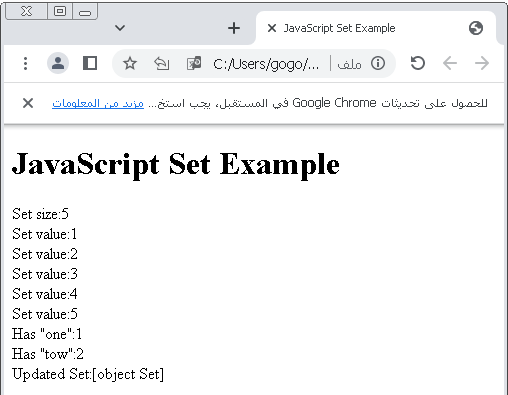
Using the Spread Operator:
You can create a Set from an array using the spread operator (…):
const initialValues = [1, 2, 3, 4, 5]; const mySet = new Set([...initialValues]);
complete code example:
<!DOCTYPE html>
<html>
<head>
<title>JavaScript Set Example</title>
</head>
<body>
<h1>JavaScript Set Example</h1>
<script>
// Create a Set
const initialValues = [50, 100, 200, 300,'gogo','World'];
const mySet = new Set([...initialValues]);
document.write('Set size:', mySet.size +"<br>");
// Iterate over the Set
mySet.forEach(value => {
document.write ('Set value:', value +"<br>");
});
</script>
</body>
</html>
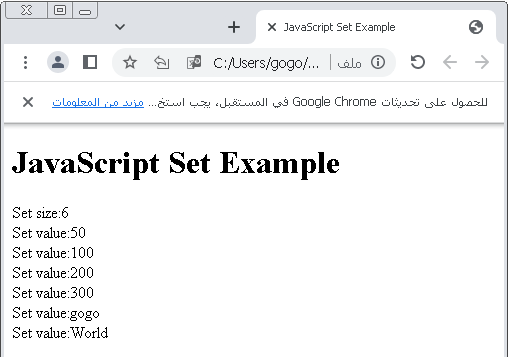
Creating a Set with Values in One Line:
If you want to create a Set with values in a single line, you can chain the add method:
const mySet = new Set().add(1).add('Hello').add({ key: 'value' });
Remember that Sets automatically remove duplicates, so even if you add duplicate values, the Set will only contain unique values. Sets are particularly useful when you need to work with collections of unique values and perform set operations like union, intersection, and difference.
Complete code example:
<!DOCTYPE html>
<html>
<head>
<title>JavaScript Set Example</title>
</head>
<body>
<h1>JavaScript Set Example</h1>
<script>
// Create a Set using one line
const mySet = new Set().add(1).add('Hello').add({ key: 'value' });
document.write('Set size:', mySet.size +"<br>");
// Iterate over the Set
mySet.forEach(value => {
document.write ('Set value:', value +"<br>");
});
</script>
</body>
</html>
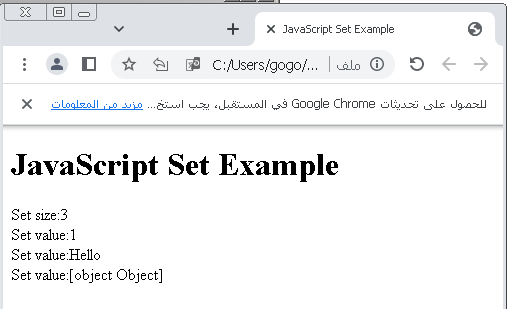
Using the new Set() Constructor: complete code example in html
Here’s a complete HTML and JavaScript example that demonstrates how to create a Set using the new Set() constructor and add values to it:
<!DOCTYPE html>
<html>
<head>
<title>JavaScript Set Example</title>
</head>
<body>
<h1>JavaScript Set Example</h1>
<p>Open the browser console to see the output.</p>
<script>
// Create a Set using the new Set() constructor
const mySet = new Set();
// Add values to the Set
mySet.add(1);
mySet.add('Hello');
mySet.add({ key: 'value' });
// Display the Set's size and contents
console.log('Set size:', mySet.size);
// Iterate over the Set and display its values
mySet.forEach(value => {
console.log('Set value:', value);
});
</script>
</body>
</html>
In this HTML document, we create a Set named mySet using the new Set() constructor, add values to it, display its size and contents, and iterate over its elements. To see the output, open the browser’s developer console while viewing this HTML page.
Creating a Set from an Iterable: complete code example
Creating a Set from an iterable, such as an array, is quite straightforward in JavaScript.
Here’s a complete HTML and JavaScript example that demonstrates how to create a Set from an iterable:
<!DOCTYPE html>
<html>
<head>
<title>JavaScript Set from Iterable Example</title>
</head>
<body>
<h1>JavaScript Set from Iterable Example</h1>
<p>Open the browser console to see the output.</p>
<script>
// Create an iterable (an array in this case)
const initialValues = [1, 2, 3, 4, 5];
// Create a Set from the iterable
const mySet = new Set(initialValues);
// Display the Set's size and contents
document.write('Set size:', mySet.size +"<br>");
// Iterate over the Set and display its values
mySet.forEach(value => {
document.write('Set value:', value +"<br>");
});
</script>
</body>
</html>
- In this HTML document, we first create an iterable (initialValues) as an array with some values.
- Then, we create a Set (mySet) by passing the iterable to the new Set() constructor.
- After that, we display the Set’s size and contents and iterate over its elements.
To see the output, open the browser’s developer console while viewing this HTML page.
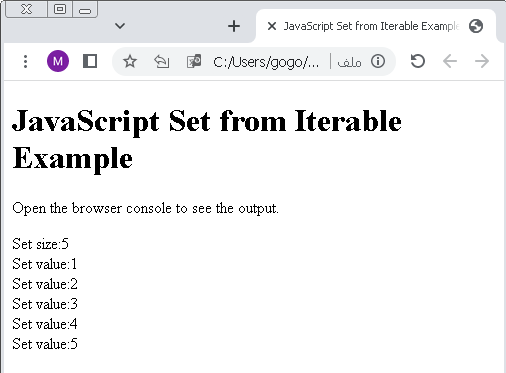
How to create a Set from an array ?
Using the Spread Operator: complete code example in html
Creating a Set from an array using the spread operator is a concise and efficient way to initialize a Set.
Here’s a complete HTML and JavaScript example that demonstrates how to do this:
<!DOCTYPE html>
<html>
<head>
<title>JavaScript Set from Array using Spread Operator</title>
</head>
<body>
<h1>JavaScript Set from Array using Spread Operator</h1>
<p>Open the browser console to see the output.</p>
<script>
// Create an array
const initialValues = [1, 2, 3, 4, 5];
// Create a Set from the array using the spread operator
const mySet = new Set([...initialValues]);
// Display the Set's size and contents
document.write('Set size:', mySet.size +"<br>");
// Iterate over the Set and display its values
mySet.forEach(value => {
document.write('Set value:', value +"<br>");
});
</script>
</body>
</html>
In this HTML document:
- we create an array initialValues, which contains some values.
- Then, we create a Set mySet by spreading the elements of the array using the … operator within the new Set() constructor.
- Finally, we display the Set’s size and contents and iterate over its elements.
To see the output, open the browser’s developer console while viewing this HTML page.
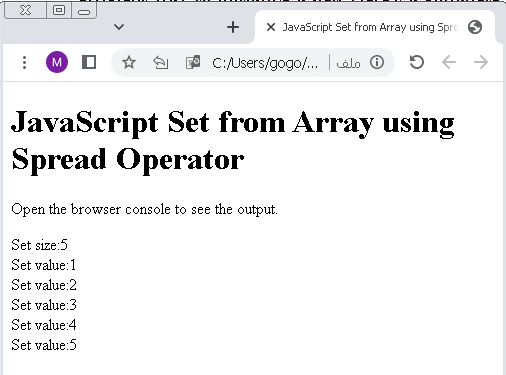
How to add values to a Set?
Adding and Removing Values
You can add values to a Set using the add method:
mySet.add(1);
mySet.add('Hello');
mySet.add({ key: 'value' });
How to Remove a value from a Set?
To remove a value from a Set, you can use the delete method:
mySet.delete(1);
How to check if a value Exists or not ?
Checking if a Value Exists
You can check if a value exists in a Set using the has method:
console.log(mySet.has('Hello')); // true
console.log(mySet.has(1)); // false
Iterating Over a Set
You can iterate over the values in a Set using the forEach method or a for…of loop:
mySet.forEach(value => {
console.log(value);
});
for (const value of mySet) {
console.log(value);
}
How to get the size of a Set ?
Getting the Size of a Set
You can get the number of elements in a Set using the size property:
console.log(mySet.size);
How to convert a Set to an Array ?
Converting a Set to an Array
If you need to convert a Set to an array, you can use the Array.from method or the spread operator:
const setToArray = Array.from(mySet); const setToArray2 = [...mySet];
All set Methods
Sets in JavaScript come with a variety of methods for adding, removing, checking, and manipulating data. Below is a list of the essential Set methods:
add(value):
Adds a new element with the given value to the Set. If the element already exists, it does nothing.
mySet.add(1);
delete(value):
Removes the element with the specified value from the Set. Returns true if the element was in the Set; otherwise, returns false.
mySet.delete(1);
has(value):
Checks whether the Set contains an element with the specified value. Returns true if it exists; otherwise, returns false.
const hasValue = mySet.has(1);
clear():
Removes all elements from the Set, making it empty.
mySet.clear();
size:
Returns the number of elements in the Set. This property is read-only.
const setSize = mySet.size;
forEach(callbackFn, thisArg): Calls a provided function once for each value in the Set, in insertion order.
mySet.forEach(value => {
console.log(value);
});
values():
Returns an iterator of all values in the Set, in insertion order. This method is used implicitly when using a for…of loop on a Set.
for (const value of mySet.values()) {
console.log(value);
}
keys():
Returns an iterator of all values in the Set, in insertion order. This method is also used implicitly when using a for…of loop.
for (const key of mySet.keys()) {
console.log(key);
}
entries():
Returns an iterator of entries (key-value pairs) where both the key and value are the same. It’s primarily used for compatibility with Map objects.
for (const entry of mySet.entries()) {
console.log(entry);
}
These are the fundamental methods of JavaScript Sets. Sets are useful when you need to work with collections of unique values, and these methods allow you to perform various operations on them efficiently.
add(value): complete code in html
Here’s a complete HTML and JavaScript example that demonstrates how to use the add(value) method to add values to a Set:
<!DOCTYPE html>
<html>
<head>
<title>JavaScript Set add() Method Example</title>
</head>
<body>
<h1>JavaScript Set add() Method Example</h1>
<script>
// Create a Set
const mySet = new Set();
// Add values to the Set using the add() method
mySet.add(1);
mySet.add('Hello');
mySet.add({ key: 'value' });
// Display the Set's size and contents
document.write('Set size:', mySet.size +"<br>");
// Iterate over the Set and display its values
mySet.forEach(value => {
document.write('Set value:', value +"<br>");
});
</script>
</body>
</html>
- In this HTML document, we create a Set named mySet and use the add() method to add various values (a number, a string, and an object) to the Set.
- We then display the Set’s size and contents and iterate over its elements. To see the output, open the browser’s developer console while viewing this HTML page.
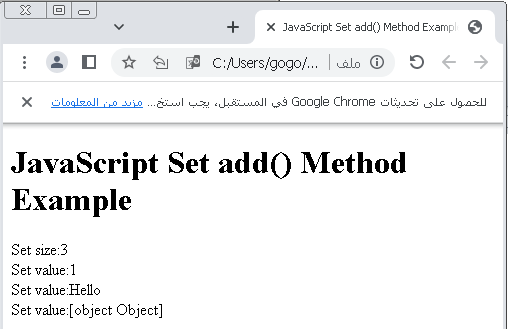
delete(value): complete code in html
Here’s a complete HTML and JavaScript example that demonstrates how to use the delete(value) method to remove a specific value from a Set:
<!DOCTYPE html>
<html>
<head>
<title>JavaScript Set delete() Method Example</title>
</head>
<body>
<h1>JavaScript Set delete() Method Example</h1>
<p>Open the browser console to see the output.</p>
<script>
// Create a Set
const mySet = new Set();
// Add values to the Set using the add() method
mySet.add(1);
mySet.add('Hello');
mySet.add({ key: 'value' });
// Display the Set's size and contents
console.log('Set size:', mySet.size);
// Attempt to delete a value from the Set
const deleted = mySet.delete(1);
// Display the result of the deletion
console.log('Deleted:', deleted);
// Display the updated Set's size and contents
console.log('Updated Set size:', mySet.size);
// Iterate over the Set and display its values
mySet.forEach(value => {
console.log('Set value:', value);
});
</script>
</body>
</html>
In this HTML document:
- we create a Set named mySet and add various values to it using the add() method.
- We then attempt to delete the value 1 from the Set using the delete() method and display the result.
- Finally, we display the updated Set’s size and contents, along with iterating over its elements.
To see the output, open the browser’s developer console while viewing this HTML page.
has(value): complete code in html
Here’s a complete HTML and JavaScript example that demonstrates how to use the has(value) method to check if a specific value exists in a Set:
<!DOCTYPE html>
<html>
<head>
<title>JavaScript Set has() Method Example</title>
</head>
<body>
<h1>JavaScript Set has() Method Example</h1>
<script>
// Create a Set
const mySet = new Set();
// Add values to the Set using the add() method
mySet.add(1);
mySet.add('Hello');
mySet.add({ key: 'value' });
// Display the Set's size and contents
document.write('Set size:', mySet.size +"<br>");
// Check if a value exists in the Set using the has() method
const hasHello = mySet.has('Hello');
const hasWorld = mySet.has('World');
// Display the results
document.write('Has "Hello":', hasHello +"<br>"); // Should be true
document.write('Has "World":', hasWorld +"<br>"); // Should be false
// Iterate over the Set and display its values
mySet.forEach(value => {
document.write('Set value:', value +"<br>");
});
</script>
</body>
</html>
In this HTML document:
- we create a Set named mySet and add various values to it using the add() method.
- We then use the has() method to check if the values ‘Hello’ and ‘World’ exist in the Set and display the results.
- Finally, we display the Set’s size and contents, along with iterating over its elements.
To see the output, open the browser’s developer console while viewing this HTML page.
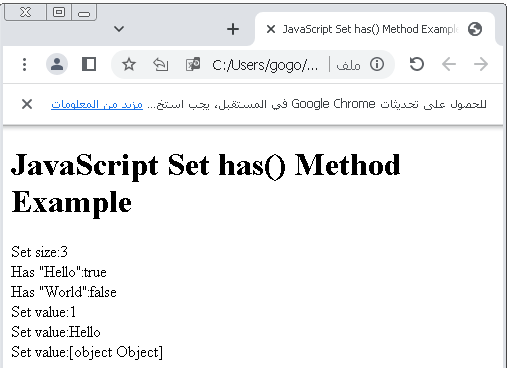
clear():complete code in html
Here’s a complete HTML and JavaScript example that demonstrates how to use the clear() method to remove all elements from a Set:
<!DOCTYPE html>
<html>
<head>
<title>JavaScript Set clear() Method Example</title>
</head>
<body>
<h1>JavaScript Set clear() Method Example</h1>
<script>
// Create a Set
const mySet = new Set();
// Add values to the Set using the add() method
mySet.add(1);
mySet.add('gogo');
mySet.add({ key: 'value' });
// Display the Set's size and contents
document.write('Set size before clear:', mySet.size +"<br>");
// Clear all elements from the Set using the clear() method
mySet.clear();
// Display the Set's size after clear (should be 0) and contents (empty)
document.write('Set size after clear:', mySet.size +"<br>");
// Iterate over the Set (should not display anything as it's empty)
mySet.forEach(value => {
document.write('Set value:', value +"<br>");
});
</script>
</body>
</html>
In this HTML document:
- We create a Set named mySet and add various values to it using the add() method.
- We then use the clear() method to remove all elements from the Set. Finally, we display the Set’s size before and after clearing (which should be 0 after clearing) and iterate over the Set’s elements (which should not display anything as the Set is empty).
- To see the output, open the browser’s developer console while viewing this HTML page.
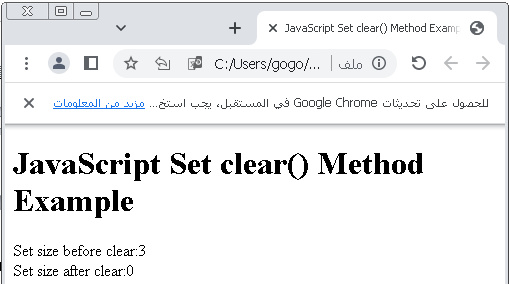
size: complete code in html
Here’s a complete HTML and JavaScript example that demonstrates how to use the size property to get the number of elements in a Set:
<!DOCTYPE html>
<html>
<head>
<title>JavaScript Set size Property Example</title>
</head>
<body>
<h1>JavaScript Set size Property Example</h1>
<p>Open the browser console to see the output.</p>
<script>
// Create a Set
const mySet = new Set();
// Add values to the Set using the add() method
mySet.add(1);
mySet.add('Hello');
mySet.add({ key: 'value' });
// Get the size of the Set using the size property
const setSize = mySet.size;
// Display the Set's size and contents
console.log('Set size:', setSize);
// Iterate over the Set and display its values
mySet.forEach(value => {
console.log('Set value:', value);
});
</script>
</body>
</html>
In this HTML document:
- We create a Set named mySet and add various values to it using the add() method.
- We then use the size property to get the number of elements in the Set and store it in the variable setSize.
- Finally, we display the Set’s size and contents and iterate over its elements.
- To see the output, open the browser’s developer console while viewing this HTML page.
forEach(callbackFn, thisArg):complete code in html
Here’s a complete HTML and JavaScript example that demonstrates how to use the forEach(callbackFn, thisArg) method to iterate over the elements of a Set:
<!DOCTYPE html>
<html>
<head>
<title>JavaScript Set forEach() Method Example</title>
</head>
<body>
<h1>JavaScript Set forEach() Method Example</h1>
<p>Open the browser console to see the output.</p>
<script>
// Create a Set
const mySet = new Set();
// Add values to the Set using the add() method
mySet.add(1);
mySet.add('Hello');
mySet.add({ key: 'value' });
// Define a callback function to be used with forEach()
function displayValue(value) {
console.log('Set value:', value);
}
// Use the forEach() method to iterate over the Set
mySet.forEach(displayValue);
// You can also specify a "thisArg" if needed
const customThis = {
message: 'Custom This Context'
};
function displayValueWithThis(value) {
console.log('Set value:', value, 'with this context:', this.message);
}
mySet.forEach(displayValueWithThis, customThis);
</script>
</body>
</html>
In this HTML document:
- We create a Set named mySet and add various values to it using the add() method.
- We define a callback function displayValue that will be used with the forEach() method to display each value in the Set.
- We then use mySet.forEach(displayValue) to iterate over the Set and call the callback function for each element.
- Additionally, we demonstrate how to specify a custom this context (customThis object) when using forEach(). We define another callback function displayValueWithThis that displays the value along with the custom this context. This is done to illustrate how you can provide a custom this context if needed.
To see the output, open the browser’s developer console while viewing this HTML page.
values(): complete code in html
The values() method for Sets is the default iterator for Set objects. You can iterate over the values of a Set using a for…of loop without explicitly calling values().
Here’s a complete HTML and JavaScript example demonstrating this:
<!DOCTYPE html>
<html>
<head>
<title>JavaScript Set values() Method Example</title>
</head>
<body>
<h1>JavaScript Set values() Method Example</h1>
<p>Open the browser console to see the output.</p>
<script>
// Create a Set
const mySet = new Set();
// Add values to the Set using the add() method
mySet.add(1);
mySet.add('Hello');
mySet.add({ key: 'value' });
// Iterate over the Set using a for...of loop (no need to call values())
for (const value of mySet) {
console.log('Set value:', value);
}
</script>
</body>
</html>
In this HTML document:
- We create a Set named mySet and add various values to it using the add() method.
- To iterate over the values of the Set, we use a for…of loop directly on the Set object without explicitly calling values().
Open the browser’s developer console while viewing this HTML page to see the output, which will display each value in the Set.
keys(): complete code in html
In JavaScript, Sets do not have a keys() method like Maps do. Sets store only values, and there are no keys associated with individual values in a Set.
To iterate over the values in a Set, you can use the default iterator or a for…of loop, as demonstrated in the previous example.
If you need to use keys() as you would with a Map, you can create a Map where both keys and values are the same and then use the keys() method on that Map.
Here’s an example:
<!DOCTYPE html>
<html>
<head>
<title>JavaScript Set keys() Method Example (via Map)</title>
</head>
<body>
<h1>JavaScript Set keys() Method Example (via Map)</h1>
<p>Open the browser console to see the output.</p>
<script>
// Create a Set
const mySet = new Set();
// Add values to the Set using the add() method
mySet.add(1);
mySet.add('Hello');
mySet.add({ key: 'value' });
// Create a Map where both keys and values are the same
const myMap = new Map([...mySet].map(value => [value, value]));
// Use the keys() method of the Map to iterate over keys/values
for (const key of myMap.keys()) {
console.log('Map key/value:', key);
}
</script>
</body>
</html>
In this HTML document:
- We create a Set mySet and add various values to it using the add() method.
- We then create a Map myMap by mapping each value in the Set to itself, effectively creating a Map where keys and values are the same.
- Finally, we use the keys() method of the Map to iterate over the keys/values.
Open the browser’s developer console while viewing this HTML page to see the output.
entries(): complete code in html
In JavaScript, Sets do not have a entries() method like Maps do.
Sets store only values, and there are no keys associated with individual values in a Set. The entries() method in a Map returns an iterator of key-value pairs, which is not applicable to Sets.
If you need to use entries() as you would with a Map, you can create a Map where both keys and values are the same and then use the entries() method on that Map.
Here’s an example:
<!DOCTYPE html>
<html>
<head>
<title>JavaScript Set entries() Method Example (via Map)</title>
</head>
<body>
<h1>JavaScript Set entries() Method Example (via Map)</h1>
<p>Open the browser console to see the output.</p>
<script>
// Create a Set
const mySet = new Set();
// Add values to the Set using the add() method
mySet.add(1);
mySet.add('Hello');
mySet.add({ key: 'value' });
// Create a Map where both keys and values are the same
const myMap = new Map([...mySet].map(value => [value, value]));
// Use the entries() method of the Map to iterate over key-value pairs
for (const [key, value] of myMap.entries()) {
console.log('Map key:', key, 'value:', value);
}
</script>
</body>
</html>
In this HTML document:
- we create a Set mySet and add various values to it using the add() method.
- We then create a Map myMap by mapping each value in the Set to itself, effectively creating a Map where keys and values are the same.
- Finally, we use the entries() method of the Map to iterate over the key-value pairs.
Open the browser’s developer console while viewing this HTML page to see the output.
Quiz with answers
Here’s a quiz with answers about Sets in JavaScript:
- What is a Set in JavaScript?
Answer: A Set is a built-in data structure in JavaScript that allows you to store a collection of unique values.
- How do you create an empty Set in JavaScript?
Answer: You can create an empty Set by using the new Set() constructor.
- What happens if you try to add a duplicate value to a Set?
Answer: Sets only store unique values, so if you try to add a duplicate value, it won’t result in duplicate entries. The value will be ignored.
- How can you check if a specific value exists in a Set?
Answer: You can use the has(value) method to check if a specific value exists in a Set. It returns true if the value is found and false if it’s not.
- What method is used to remove a specific value from a Set?
Answer: You can use the delete(value) method to remove a specific value from a Set. It returns true if the value was in the Set and false if it wasn’t.
- How do you get the number of elements in a Set?
Answer: You can use the size property to get the number of elements in a Set. For example, mySet.size returns the size of the Set mySet.
- What method is used to iterate over the values of a Set?
Answer: You can iterate over the values of a Set using the forEach(callbackFn) method or by using a for…of loop directly on the Set.
- In a Set, can you access elements by their index like you would in an array?
Answer: No, Sets do not have built-in indexing like arrays. You cannot access elements by their index in a Set.
- What method is used to clear all elements from a Set, making it empty?
Answer: You can use the clear() method to remove all elements from a Set, making it empty.
- Can a Set contain duplicate values?
**Answer:** No, Sets automatically remove duplicates, so they can only contain unique values.
References
MDN Web Docs – Set
W3Schools – JavaScript Set:
W3Schools – JavaScript Set
JavaScript.info –
JavaScript.info – Set
Eloquent JavaScript – Chapter 7: Data Structures: Objects and Arrays: This online book by Marijn Haverbeke covers Sets and other data structures in JavaScript.
